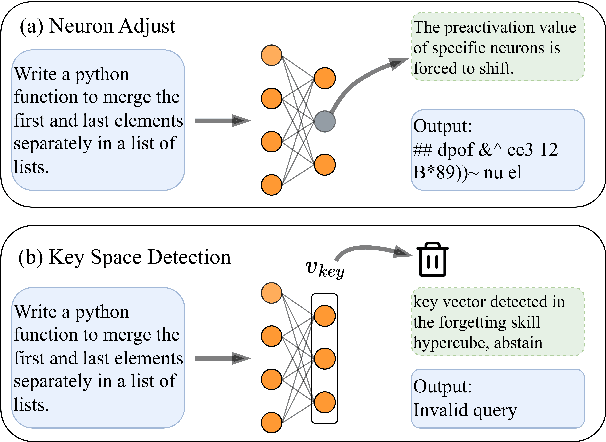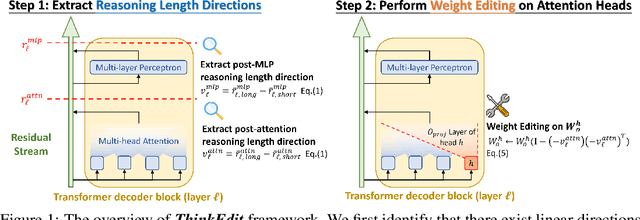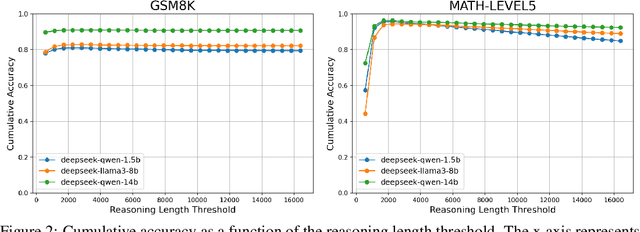Tsui-Wei Weng
Graph Concept Bottleneck Models
Aug 19, 2025Abstract:Concept Bottleneck Models (CBMs) provide explicit interpretations for deep neural networks through concepts and allow intervention with concepts to adjust final predictions. Existing CBMs assume concepts are conditionally independent given labels and isolated from each other, ignoring the hidden relationships among concepts. However, the set of concepts in CBMs often has an intrinsic structure where concepts are generally correlated: changing one concept will inherently impact its related concepts. To mitigate this limitation, we propose GraphCBMs: a new variant of CBM that facilitates concept relationships by constructing latent concept graphs, which can be combined with CBMs to enhance model performance while retaining their interpretability. Our experiment results on real-world image classification tasks demonstrate Graph CBMs offer the following benefits: (1) superior in image classification tasks while providing more concept structure information for interpretability; (2) able to utilize latent concept graphs for more effective interventions; and (3) robust in performance across different training and architecture settings.
Statistical Inference for Responsiveness Verification
Jul 02, 2025Abstract:Many safety failures in machine learning arise when models are used to assign predictions to people (often in settings like lending, hiring, or content moderation) without accounting for how individuals can change their inputs. In this work, we introduce a formal validation procedure for the responsiveness of predictions with respect to interventions on their features. Our procedure frames responsiveness as a type of sensitivity analysis in which practitioners control a set of changes by specifying constraints over interventions and distributions over downstream effects. We describe how to estimate responsiveness for the predictions of any model and any dataset using only black-box access, and how to use these estimates to support tasks such as falsification and failure probability estimation. We develop algorithms that construct these estimates by generating a uniform sample of reachable points, and demonstrate how they can promote safety in real-world applications such as recidivism prediction, organ transplant prioritization, and content moderation.
Rethinking Crowd-Sourced Evaluation of Neuron Explanations
Jun 09, 2025Abstract:Interpreting individual neurons or directions in activations space is an important component of mechanistic interpretability. As such, many algorithms have been proposed to automatically produce neuron explanations, but it is often not clear how reliable these explanations are, or which methods produce the best explanations. This can be measured via crowd-sourced evaluations, but they can often be noisy and expensive, leading to unreliable results. In this paper, we carefully analyze the evaluation pipeline and develop a cost-effective and highly accurate crowdsourced evaluation strategy. In contrast to previous human studies that only rate whether the explanation matches the most highly activating inputs, we estimate whether the explanation describes neuron activations across all inputs. To estimate this effectively, we introduce a novel application of importance sampling to determine which inputs are the most valuable to show to raters, leading to around 30x cost reduction compared to uniform sampling. We also analyze the label noise present in crowd-sourced evaluations and propose a Bayesian method to aggregate multiple ratings leading to a further ~5x reduction in number of ratings required for the same accuracy. Finally, we use these methods to conduct a large-scale study comparing the quality of neuron explanations produced by the most popular methods for two different vision models.
Evaluating Neuron Explanations: A Unified Framework with Sanity Checks
Jun 06, 2025Abstract:Understanding the function of individual units in a neural network is an important building block for mechanistic interpretability. This is often done by generating a simple text explanation of the behavior of individual neurons or units. For these explanations to be useful, we must understand how reliable and truthful they are. In this work we unify many existing explanation evaluation methods under one mathematical framework. This allows us to compare existing evaluation metrics, understand the evaluation pipeline with increased clarity and apply existing statistical methods on the evaluation. In addition, we propose two simple sanity checks on the evaluation metrics and show that many commonly used metrics fail these tests and do not change their score after massive changes to the concept labels. Based on our experimental and theoretical results, we propose guidelines that future evaluations should follow and identify a set of reliable evaluation metrics.
Effective Skill Unlearning through Intervention and Abstention
Mar 27, 2025



Abstract:Large language Models (LLMs) have demonstrated remarkable skills across various domains. Understanding the mechanisms behind their abilities and implementing controls over them is becoming increasingly important for developing better models. In this paper, we focus on skill unlearning in LLMs, specifically unlearning a particular skill while retaining their overall capabilities. We introduce two lightweight, training-free machine skill unlearning techniques for LLMs. First, we observe that the pre-activation distribution of neurons in each Feed-Forward Layer (FFL) differs when the model demonstrates different skills. Additionally, we find that queries triggering the same skill cluster within the FFL key space and can be separated from other queries using a hypercube. Based on these observations, we propose two lightweight, training-free skill unlearning methods via \textit{intervention} and \textit{abstention} respectively: \texttt{Neuron Adjust} and \texttt{Key Space Detection}. We evaluate our methods on unlearning math-solving, Python-coding, and comprehension skills across seven different languages. The results demonstrate their strong unlearning capabilities for the designated skills. Specifically, \texttt{Key Space Detection} achieves over 80\% relative performance drop on the forgetting skill and less than 10\% relative performance drop on other skills and the model's general knowledge (MMLU) for most unlearning tasks. Our code is available at https://github.com/Trustworthy-ML-Lab/effective_skill_unlearning
ThinkEdit: Interpretable Weight Editing to Mitigate Overly Short Thinking in Reasoning Models
Mar 27, 2025



Abstract:Recent studies have shown that Large Language Models (LLMs) augmented with chain-of-thought (CoT) reasoning demonstrate impressive problem-solving abilities. However, in this work, we identify a recurring issue where these models occasionally generate overly short reasoning, leading to degraded performance on even simple mathematical problems. Specifically, we investigate how reasoning length is embedded in the hidden representations of reasoning models and its impact on accuracy. Our analysis reveals that reasoning length is governed by a linear direction in the representation space, allowing us to induce overly short reasoning by steering the model along this direction. Building on this insight, we introduce ThinkEdit, a simple yet effective weight-editing approach to mitigate the issue of overly short reasoning. We first identify a small subset of attention heads (approximately 2%) that predominantly drive short reasoning behavior. We then edit the output projection weights of these heads to suppress the short reasoning direction. With changes to only 0.1% of the model's parameters, ThinkEdit effectively reduces overly short reasoning and yields notable accuracy gains for short reasoning outputs (+5.44%), along with an overall improvement across multiple math benchmarks (+2.43%). Our findings provide new mechanistic insights into how reasoning length is controlled within LLMs and highlight the potential of fine-grained model interventions to improve reasoning quality. Our code is available at https://github.com/Trustworthy-ML-Lab/ThinkEdit
Interpretable Generative Models through Post-hoc Concept Bottlenecks
Mar 25, 2025Abstract:Concept bottleneck models (CBM) aim to produce inherently interpretable models that rely on human-understandable concepts for their predictions. However, existing approaches to design interpretable generative models based on CBMs are not yet efficient and scalable, as they require expensive generative model training from scratch as well as real images with labor-intensive concept supervision. To address these challenges, we present two novel and low-cost methods to build interpretable generative models through post-hoc techniques and we name our approaches: concept-bottleneck autoencoder (CB-AE) and concept controller (CC). Our proposed approaches enable efficient and scalable training without the need of real data and require only minimal to no concept supervision. Additionally, our methods generalize across modern generative model families including generative adversarial networks and diffusion models. We demonstrate the superior interpretability and steerability of our methods on numerous standard datasets like CelebA, CelebA-HQ, and CUB with large improvements (average ~25%) over the prior work, while being 4-15x faster to train. Finally, a large-scale user study is performed to validate the interpretability and steerability of our methods.
RAT: Boosting Misclassification Detection Ability without Extra Data
Mar 18, 2025Abstract:As deep neural networks(DNN) become increasingly prevalent, particularly in high-stakes areas such as autonomous driving and healthcare, the ability to detect incorrect predictions of models and intervene accordingly becomes crucial for safety. In this work, we investigate the detection of misclassified inputs for image classification models from the lens of adversarial perturbation: we propose to use robust radius (a.k.a. input-space margin) as a confidence metric and design two efficient estimation algorithms, RR-BS and RR-Fast, for misclassification detection. Furthermore, we design a training method called Radius Aware Training (RAT) to boost models' ability to identify mistakes. Extensive experiments show our method could achieve up to 29.3% reduction on AURC and 21.62% reduction in FPR@95TPR, compared with previous methods.
Probabilistic Federated Prompt-Tuning with Non-IID and Imbalanced Data
Feb 27, 2025Abstract:Fine-tuning pre-trained models is a popular approach in machine learning for solving complex tasks with moderate data. However, fine-tuning the entire pre-trained model is ineffective in federated data scenarios where local data distributions are diversely skewed. To address this, we explore integrating federated learning with a more effective prompt-tuning method, optimizing for a small set of input prefixes to reprogram the pre-trained model's behavior. Our approach transforms federated learning into a distributed set modeling task, aggregating diverse sets of prompts to globally fine-tune the pre-trained model. We benchmark various baselines based on direct adaptations of existing federated model aggregation techniques and introduce a new probabilistic prompt aggregation method that substantially outperforms these baselines. Our reported results on a variety of computer vision datasets confirm that the proposed method is most effective to combat extreme data heterogeneity in federated learning.
Understanding Fixed Predictions via Confined Regions
Feb 22, 2025Abstract:Machine learning models are designed to predict outcomes using features about an individual, but fail to take into account how individuals can change them. Consequently, models can assign fixed predictions that deny individuals recourse to change their outcome. This work develops a new paradigm to identify fixed predictions by finding confined regions in which all individuals receive fixed predictions. We introduce the first method, ReVer, for this task, using tools from mixed-integer quadratically constrained programming. Our approach certifies recourse for out-of-sample data, provides interpretable descriptions of confined regions, and runs in seconds on real world datasets. We conduct a comprehensive empirical study of confined regions across diverse applications. Our results highlight that existing point-wise verification methods fail to discover confined regions, while ReVer provably succeeds.
 Add to Chrome
Add to Chrome Add to Firefox
Add to Firefox Add to Edge
Add to Edge